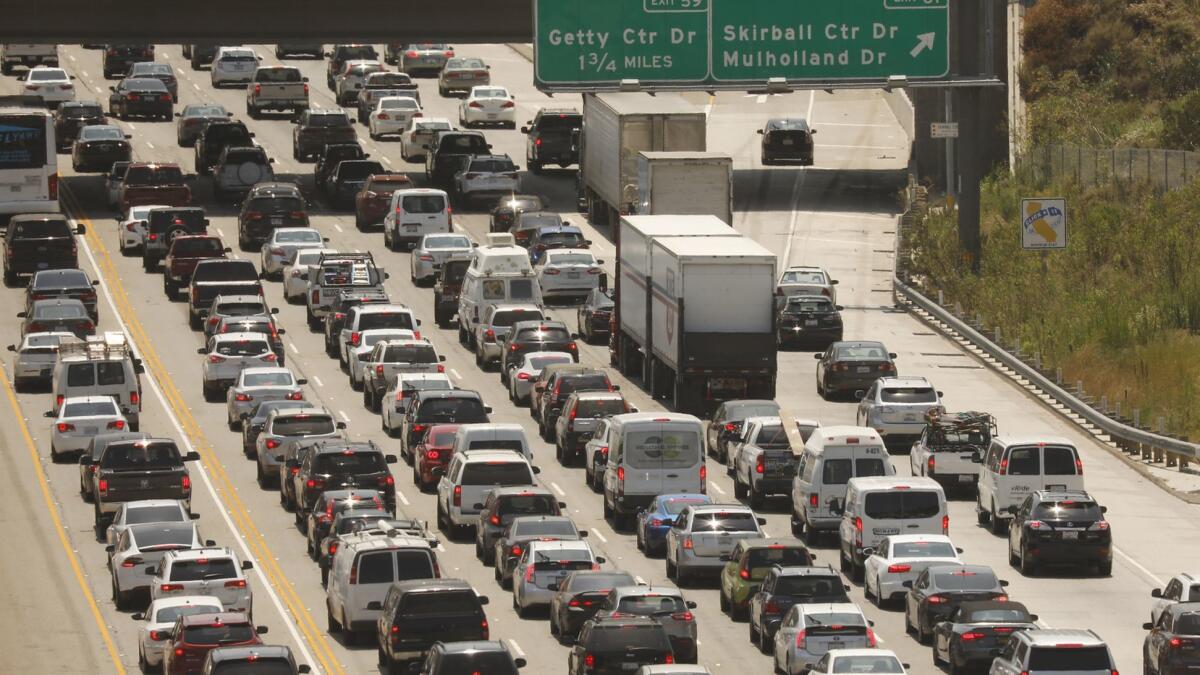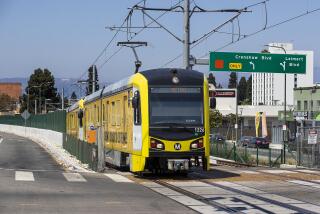Toll lanes in the Sepulveda Pass? The 405 Freeway is moving in that direction

Los Angeles County spent 4½ years and more than $1.6 billion to widen the 405 Freeway through the Sepulveda Pass.
Now, the carpool lane born from that mega-project is facing a major change of its own: tolls.
The Metropolitan Transportation Authority is in the early stages of planning to allow solo drivers in the 405’s carpool lanes, for a price. Similar programs on portions of the 110 and 10 freeways charge drivers a per-mile toll that changes based on traffic conditions.
A faster way would be welcome news for the tens of thousands of daily commuters who slog through the Sepulveda Pass. How the program would guarantee a faster trip in a carpool lane already crowded during peak periods has yet to be determined.
The toll lanes would run between the 101 Freeway in the San Fernando Valley and the 10 Freeway in West L.A. If approved, officials say, the lanes would open to drivers in 2027, just before Los Angeles hosts the 2028 Summer Olympics.
“We’re anticipating a very large number of visitors,” said Alice Tolar, a Metro senior transportation planner. “Not only would we want to improve things for our regular, ongoing users, but we’d want to improve things in time to represent Los Angeles County.”
On Thursday, Metro’s board is scheduled to consider a three-year, $27.5-million contract to move the 405 toll lane project closer to construction.
Metro staff have recommended hiring the engineering firm WSP USA Inc., formerly Parsons Brinckerhoff, to prepare an environmental analysis, a traffic study and a detailed cost estimate.
The toll lanes are being developed in parallel with a rail mega-project through the Sepulveda Pass.
The transit line, which will either be a subway or a monorail, has an estimated price tag of $9.4 billion to $13.8 billion and a tunnel as long as 13 miles through the Santa Monica Mountains.
The rail project has about $5.7 billion earmarked from Measure M, the sales tax increase that county voters approved in 2016, leaving an estimated shortfall of at least $3.7 billion.
Metro officials have previously said that revenue from the 405 toll lanes could be used to help fund the Sepulveda Pass rail line by creating a revenue source that Metro could borrow against.
The widening of the 405 added a single carpool lane in each direction. Metro’s study will examine whether there is enough space in the freeway’s auxiliary areas to create a second lane for tolled trips, or whether Metro would have space to convert only the carpool lane to a single HOV lane.
The toll lanes have $260 million through Measure M, available starting in 2024. The study will determine whether the project will need to find additional money, said Shahrzad Amiri, a Metro deputy executive officer.
The 405 toll lanes will be modeled after the Expresslanes on the 110 Freeway between Exposition Park and the South Bay and the 10 Freeway between downtown and El Monte.
The lanes are free to vehicles with multiple occupants, provided they have a transponder. Carpools of two or more people get a free ride on the 110; on the 10, carpools must have three or more occupants during peak periods.
Drivers who are alone in the car and enter the ExpressLanes are charged a per-mile price that starts at 25 cents and rises as congestion in the paid lanes grows worse.
The per-mile price, which Metro has raised seven times since 2012, is now capped at $2.10, creating a maximum toll of $23.10 on the 110 and $29.40 on the 10.
The higher prices are designed to keep some users out of the lane, and force others to exit, leaving faster travel speeds for those who do pay.
All carpool and toll lanes that receive federal funds are required to maintain average speeds of 45 mph at least 90% of the time during peak periods. Less than 30% of the lanes in California meet that goal, and the percentage is even lower in Los Angeles County, according to Caltrans.
No portion of the 405 carpool lane in Los Angeles County met that standard more than 25% of the time in 2017, according to the most recent data available from Caltrans. The cause of the congestion, analysts wrote in a state report, was that “demand exceeds capacity.”
How the 405’s carpool lane would accommodate drivers alone in their cars, and still meet federal speed standards, is unclear. Caltrans did not return a request seeking comment. The question will be addressed in the traffic study, Metro officials said.
The 405 proposal is part of a broader Metro plan to convert carpool lanes to toll lanes on more than a dozen segments of Los Angeles County freeways. The plan calls for eight projects, including the 405, to be completed by 2027.
That includes the 105 Freeway between the 405 and the 605 Freeway, and an extension of the ExpressLanes on the 10 from El Monte to the San Bernardino County line.
More to Read
Sign up for Essential California
The most important California stories and recommendations in your inbox every morning.
You may occasionally receive promotional content from the Los Angeles Times.










